
- Afrikaans
- Arabic
- Belarusian
- Bengali
- Czech
- Danish
- Dutch
- English
- Esperanto
- Estonian
- Finnish
- French
- German
- Greek
- Hindi
- Hungarian
- Icelandic
- Indonesian
- irish
- Italian
- Japanese
- kazakh
- Rwandese
- Korean
- Kyrgyz
- Lao
- Latin
- Latvian
- Malay
- Mongolian
- Myanmar
- Norwegian
- Persian
- Polish
- Portuguese
- Romanian
- Russian
- Serbian
- Spanish
- Swedish
- Tagalog
- Tajik
- Thai
- Turkish
- Turkmen
- Ukrainian
- Urdu
- Uighur
- Uzbek
- Vietnamese
Benefits of Using Turf Over Concrete in Outdoor Spaces
Oct . 16, 2024 12:15 Back to list
The Benefits of Turf Over Concrete A Comparative Analysis
In urban landscapes where concrete predominates, the idea of integrating natural elements such as artificial turf has gained traction. With cities expanding and green spaces diminishing, the prospect of replacing areas of concrete with turf offers both aesthetic and functional advantages. This article explores the benefits of turf over concrete, examining aspects such as environmental impact, usability, aesthetic appeal, and economic considerations.
Environmental Benefits
One of the most significant advantages of installing turf over concrete is the environmental impact. Concrete surfaces contribute to urban heat islands, where temperatures are significantly warmer than in surrounding areas. Turf, on the other hand, has a cooling effect, helping to lower ambient temperatures. By absorbing sunlight and providing shade, turf can reduce the heat island effect, leading to cooler environments in urban areas.
Moreover, turf can greatly improve water drainage and reduce runoff. Concrete surfaces are impermeable, which means that rainwater cannot infiltrate the ground. This can lead to increased flooding and water quality issues, as runoff carries pollutants directly into waterways. Turf allows water to permeate the surface, recharging groundwater and filtering pollutants naturally. By creating a healthier urban ecosystem, adopting turf can play a crucial role in sustainable development.
Usability and Functionality
Another notable advantage of turf is its functional usability in public and recreational spaces. Traditional concrete surfaces can often be unwelcoming and uncomfortable for various activities. For instance, playgrounds or sports fields made of concrete can be harsh on children and athletes, increasing the risk of injuries. In contrast, artificial turf provides a softer, more cushioned surface that enhances safety for users.
Turf can also be adapted for multiple uses, from recreational sports fields to community parks. It can accommodate various sports, including soccer, football, and field hockey, enhancing the versatility of urban spaces. Incorporating turf facilitates year-round usability, as advancements in artificial grass technology have made many varieties resistant to wear and tear, weather fluctuations, and UV degradation. This longevity turns turf into a more practical solution for areas that need continuous use, unlike concrete, which can crack and become unsightly over time.
turf over concrete

Aesthetic Appeal
Aesthetic value is another essential consideration when comparing turf to concrete. While concrete surfaces often appear stark and uninviting, turf introduces a vibrant, verdant atmosphere that enhances the overall aesthetic of an area. Parks, gardens, and recreational spaces featuring turf can create inviting environments that encourage outdoor activities and community interaction.
Landscaping with turf allows for more creativity in design. It can be combined with ornamental plants, trees, and flower beds, creating beautiful outdoor spaces that elevate the quality of life for residents. This natural beauty has been shown to have psychological benefits, increasing well-being and reducing stress levels. An environment that promotes greenery not only enhances visual appeal but also fosters a sense of community.
Economic Considerations
Investing in turf over concrete can also translate into long-term economic benefits. Although the initial cost of installing turf may be higher than pouring concrete, the return on investment is often significant. Turf requires less maintenance than concrete surfaces, which typically need regular repairs and resurfacing. Furthermore, turf can attract more visitors to parks and recreational centers, boosting local economies through enhanced use of public facilities.
In addition, the climate benefits associated with turf—such as reducing energy costs associated with heating and cooling—can lead to further economic savings for municipalities. Cities investing in green infrastructure are likely to see long-term financial advantages, including lower healthcare costs due to improved air quality and healthier populations.
Conclusion
In conclusion, the advantages of turf over concrete are manifold and extend across environmental, functional, aesthetic, and economic domains. As cities seek to create more livable and sustainable environments, the integration of turf into urban areas represents an opportunity to enhance urban life while combating pressing environmental issues. By prioritizing answers to our industrial landscape's shortcomings, we can pave the way for greener and healthier urban spaces that benefit everyone.
-
The Benefits of Artificial Turf for Indoors
NewsJul.15,2025
-
How Artificial Grass Suppliers Ensure Quality Products
NewsJul.15,2025
-
Artificial Grass and Pets: A Space for Relaxation
NewsJul.08,2025
-
Balcony & Outdoor Decoration with Artificial Grass
NewsJul.08,2025
-
Best Indoor Artificial Grass for Home
NewsJul.07,2025
-
Best Pet Turf for Dogs: Safe & Durable Artificial Grass Options
NewsJul.07,2025
Products categories









